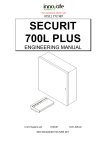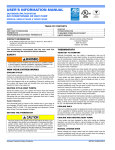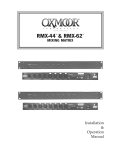Download C9970 Voltage Detector Handbook
Transcript
C9970 Voltage Detector Handbook Contents Introduction ........................................................................ 1 Warranty ............................................................................ 1 Disclaimer ........................................................................... 1 Safety Information ............................................................. 2 Care and Maintenance ....................................................... 3 Mechanical Shock ........................................................ 3 Environment ................................................................. 3 Water ............................................................................. 3 Marking ........................................................................ 3 Carrying ........................................................................ 3 Storing .......................................................................... 3 Battery Replacement .................................................... 3 Safety Gloves ...................................................................... 4 Theory of Operation .......................................................... 4 Physical Description ........................................................... 5 Accessories .......................................................................... 5 Test Plug ....................................................................... 5 Temporary Bond ........................................................... 5 Storage Bag .................................................................. 6 Ground Cord ................................................................. 6 Periodic Performance Tests ............................................... 6 Self Check .................................................................... 6 Test Plug Threshold Test .............................................. 7 Service Center Certification ......................................... 8 Operation ............................................................................ 8 AC Hazardous Voltage Testing ..................................... 9 DC Hazardous Voltage Testing ................................... 10 Aerial Testing ............................................................. 10 Applications ...................................................................... 11 Ground Level .............................................................. 11 Telephone Cable Sheath ............................................. 11 Damaged Cable Closure ............................................. 11 Base of Pole: Telephone Plant Repairs ....................... 12 Loose Plant ................................................................. 13 Temporary Bond ......................................................... 13 Ungrounded Insulated Conductors ............................ 13 Traffic Lights .............................................................. 13 PN 1286912 January 2000 Rev. 4, 1/2000 © 2000 Communications Technology Corporation, All rights reserved. Printed in USA Introduction This handbook describes the proper care and use of the C9970 Voltage Detector and its accessories. Read this handbook completely before using the Voltage Detector. Be sure to know and follow your company’s procedures for every application. Any conflict between the procedures specified in this handbook and those of your company must be resolved before operating the Voltage Detector. The Voltage Detector is a high-voltage detection device that is intended for use in testing various conductive objects, such as power ground wires, street light fixtures, mobile homes, metal frameworks, metal conduit, pedestals, newly-driven ground rods, homes covered with metallic siding, electrical machinery, and similar items. Warranty Communications Technology Corporation warrants each Voltage Detector against defects in material and workmanship for a period of one year from the date shipped to the customer. Options and accessories are likewise warranted for a period of one year. If at any time during the warranty period the equipment malfunctions, CTC will repair, or at CTC’s option, replace the unit free of charge. The remedies listed herein are the user’s sole and exclusive remedies. CTC is not liable for any indirect, direct, incidental, or consequential damages. The owner must return the unit to the factory, shipping prepaid and packaged to the best commercial standards for electronic equipment. CTC will pay shipping charges for delivery on return. The customer is responsible for mode and cost of shipment to CTC. Warranty does not apply if the unit has been damaged by accident, misuse, or as a result of service or modification not performed or approved by authorized CTC personnel. For warranty work or questions contact customer service at 800-877-1833. When returning your unit for warranty work, a Return Material Authorization (RMA) number must be obtained from customer service at the above phone number. Disclaimer CTC makes no representation of warranties of any kind whatsoever with respect to the contents hereof and specifically disclaims any implied warranties of merchantability or fitness for any particular purpose. CTC shall not be liable for errors contained herein or for incidental or consequential damages in connection with the furnishing, performance, or use of this material. CTC reserves the right to revise this publication periodically and make changes in the content hereof. Contents of this publication may be preliminary and/or may be changed at any time without notice and without being regarded as warranty. In no event shall CTC be responsible or liable for any personal injury or property damage resulting from the failure of the user to use the device strictly in accordance with these instructions. 1 Safety Information Use the Voltage Detector only as specified in this manual. Otherwise, the protection provided by the Voltage Detector may be impaired. Refer to safety information in the Warnings and Cautions table. A Warning identifies conditions and actions that pose hazards to the user. A Caution identifies conditions and actions that may damage the Voltage Detector or the equipment under test. WWarning To avoid possible electric shock or personal injury, follow these guidelines: • Only qualified personnel who have been trained and are knowledgeable about the dangers associated with hazardous voltages should use this product. • Do not use the Voltage Detector if it is damaged. Before you use the Voltage Detector, inspect the case. Look for cracks or missing plastic. Pay particular attention to the insulation surrounding the connectors. • Do not use if wet. • Inspect the voltage detector for damaged insulation or exposed metal. • Do not use the Voltage Detector if it operates abnormally. Protection may be impaired. When in doubt, have the Voltage Detector serviced. • Do not operate the Voltage Detector around explosive gas, vapor, or dust. • Do not apply more than the rated voltage, as marked on the Voltage Detector, between terminals or between any terminal and earth ground. • Before use, verify the Voltage Detector’s operation by measuring a known voltage. • When servicing the Voltage Detector, use only specified replacement parts. • Use caution when working above 30 V ac rms, 42 V peak, or 60 V dc. Such voltages pose a shock hazard. • Do not use in excess of the voltage specified in this handbook. • Avoid working alone. • When using probes, keep your fingers behind the finger guards on the probes. • Remove any voltages from the Voltage Detector before accessing the battery. • Do not operate the Voltage Detector with portions of the case removed or loosened. • To avoid false indications, which could lead to possible electric shock or personal injury, replace the batteries as recommended. See the section on battery replacement for additional information. • Use only type 9 V batteries, properly installed in the Voltage Detector case, to power the Voltage Detector. Caution To avoid possible damage to the Voltage Detector or to the equipment under test, follow these guidelines: • Use the proper terminals and function for your measurements. 2 Care and Maintenance Any Voltage Detector with confirmed or suspected damage to the plastic housing (deep scratches, cracks, holes, etc.) or internal circuitry should never be used. Mechanical Shock Do not drop the Voltage Detector or subject it to severe mechanical stress which may damage the protective insulation or internal circuitry. The Voltage Detector should be tested and repaired if it appears to be damaged or fails to meet the tests described in the Periodic Performance Tests section of this handbook. Environment Do not expose the Voltage Detector to extreme temperatures (below -40° C or above 60° C) or chemicals which may soften, crack, or otherwise damage the plastic housing. Water Although the Voltage Detector is water resistant, do not expose it to water. If submerged in water, it must be dried completely and checked for proper operation before use. (If a test plug is unavailable, a 110-120 VAC, 60-Hz, source may be temporarily substituted with caution.) If the Voltage Detector appears to have taken on water, open it by unscrewing the handle in a counterclockwise direction and allow it to dry completely before closing. Do not attempt to remove the ground or check contacts or disassemble the front portion of the test set. After closing, test the Voltage Detector with a test plug before returning to use. Marking Do not drill, punch, engrave, or otherwise modify the housing of the Voltage Detector. Do not use adhesives, adhesive labels, inks, solvents, or expose to chemicals which may alter the housing. Defacing or altering the Voltage Detector may lower or destroy its sensitivity to hazardous voltages and will void the warranty. Carrying Keep the conductive cap over the probe end of the Voltage Detector when it is not in use to avoid damage to the tip and possible hazard to the user. The carbide tip is sharp and should be treated accordingly. Storing Do not subject the Voltage Detector to possible pressure or damage from other tools or material. Pressure may cause the switch to operate and discharge the battery. Do not store the Voltage Detector near strong magnets. Battery Replacement When replacing batteries, work in a dry place. Always replace the battery with a 9V, alkaline, battery. Some imported 9-V batteries are slightly oversized. If an oversized battery is tried, the metal shield may be torn from the circuit board. 3 Therefore, if the replacement battery seems tighter than the original, a different brand should be tried. To replace the Voltage Detector battery, proceed with the following steps. 1. Open the Voltage Detector body by unscrewing the handle in a counterclockwise direction and sliding it back from the front assembly. Do not attempt to loosen the check contact or the ground terminal. 2. Gently slide the battery out of the metal shield, attach a new battery, and slide it back into the metal shield. Be careful not to get the battery wires between the metal shield and the side of the battery or to bend or distort the metal shield. 3. Slide the handle over the shield and rotate in a clockwise direction until a snug fit is secured. Make sure that the LEDs line up with the trigger, or the probe switch may not operate. A snug fit is required for proper O-ring seal and LED alignment, but it is not necessary to overtighten. Safety Gloves The Voltage Detector is designed to provide protection to the user with exposure of up to 20,000-V, 60-Hz, AC. The use of gloves reduces the sensitivity of the Voltage Detector and may cause erroneous results (see the Theory of Operation section of this handbook). If protective gloves are being worn while using the Voltage Detector (or are required by company procedures) and a hazardous voltage is indicated, do not retest without gloves. Move away and refer to your company’s safety procedures. However, if the user is gloved and a safe condition is indicated, perform a second test without gloves and follow the results of this second test. Theory of Operation The Voltage Detector uses electronics and high-voltage mechanical design to indicate the presence of dangerously-high AC and DC voltages. To do so, it first determines the voltage difference between the user’s body and the object being tested. Then, it compares that difference to an internal safety reference. If the voltage difference exceeds this reference, the Voltage Detector indicates danger. No interpretation of readings is required. The capacitance between the handle of the Voltage Detector and the user’s hand is part of the measuring circuit and can affect the sensitivity of the Voltage Detector. Further, voltages induced onto the user’s body can also affect readings. Such voltages can be induced when the user is isolated from ground while working aloft near power transmission lines. These induced voltages can cause the Voltage Detector to indicate danger when none actually exists. These induced voltages are harmless, but must be discharged. The correct procedure is described under Aerial Testing in the Operation section of this handbook. 4 Physical Description The Voltage Detector, shown in Figure 1, is a yellow, plastic, two-piece, unit that weighs approximately one pound. The front housing includes the carbide probe tip and two LEDs (one green and one red) along with a check contact and a ground terminal. The entire electronic package and battery are attached to the front housing. The rear housing, which acts as a handle, includes a set of concentric rings (called the flashguard), the on-off switch (called the trigger), an instruction label, and a belt clip. LEDs (red and green) ground terminal trigger probe tip flashguard check contact conductive end cap Figure 1: Voltage Detector Accessories Test Plug The Voltage Detector test plug is used to verify the lowest voltage (threshold voltage) at which the Voltage Detector indicates danger. It is an AC-operated plug which provides a suitable, current-limited, reference voltage to verify proper operation of the Voltage Detector. It plugs into a standard, ground-referenced, power outlet. The test plug is current limited and may be touched without electrical shock, even while energized. The test plug consumes less than 30 milliwatts and may be left in an outlet indefinitely if desired. Temporary Bond The Voltage Detector temporary bond is used to temporarily ground a light fixture, metallic conduit, power company hardware, power ground wire, or other metallic objects in a work space which could become energized if a fault developed. It is a heavy-duty insulated cord equipped with a large clamp on one end and a smaller clamp on the other. The temporary bond is placed on such attachments only after the metallic object has first been tested with the Voltage Detector and found to be free of a voltage potential. When placed, the bond is first attached (small clamp) to a reliable ground source and then (large clamp) to the metallic object. When the work is completed, the bond is removed first from the metallic object and then 5 from the ground source. Should a fault develop while the temporary bond is in place, the insulation may overheat and smoke, at which time you should avoid contact with the bond. Storage Bag The Voltage Detector storage bag is designed to hold the Voltage Detector and its accessories. The bag interior is lined with plastic. Its exterior has a fabric strap with a metal snap hook for ease-of-use. Access to the interior is by means of a zipper. Ground Cord The Voltage Detector ground cord is used only in certain aerial applications where the user is isolated from ground and near power transmission lines. It is a 25-foot, retracting cord, with clamps on each end. This cord, along with the conductive plastic end cap, eliminates induced body voltage in order to prevent false hazard indications. temporary bond voltage detector storage bag ground cord Figure 2: Voltage Detector and Accessories Periodic Performance Tests The Voltage Detector must be tested periodically to ensure that it is working properly and that it retains its protective properties. Three periodic performance tests are important to the integrity of the Voltage Detector: a self check, test plug threshold (sensitivity) test, and service center certification. Self Check A self check should be performed before each use of the Voltage Detector to verify it is working properly. To perform a self check, proceed with the following steps. 1. Clean and dry the entire housing. Moisture, dirt, and other foreign matter reduces the insulating properties of the plastic surface. 6 2. Examine the housing for cracks. 3. Grasp the handle with your bare hand. Press the trigger and observe the green LED. If it does not illuminate or is very dim, check the internal battery and replace if needed. If the green LED still does not illuminate, do not use the Voltage Detector. 4. With the trigger pressed, use the free hand to touch both the probe tip and the check contact (shown in Figure 3). The red LED should flash and the green LED should go out. If they do not, the Voltage Detector is malfunctioning. Note: It may be necessary to wet the fingers that are touching the probe tip and check contact in order to start the red flashing LED. This is acceptable and does not indicate a malfunctioning Voltage Detector. 5. Once the red LED starts flashing, remove the free hand while continuing to press the trigger. The red LED should continue to flash as long as the trigger is pressed. If it does not, the Voltage Detector is malfunctioning. After passing the self check, the Voltage Detector may be used to perform a voltage test. If it does not pass, contact our Customer Service at 800-877-1833. Figure 3: Performing a Self Check Test Plug Threshold Test While the self check verifies proper operation of most of the circuits, it does not verify proper sensitivity of the Voltage Detector. Therefore, a test plug threshold test should be performed when verifying proper sensitivity, when the insulation is in doubt, or after severe mechanical stress. It should be performed at least weekly. The test plug provides the proper reference voltage for the threshold test. To perform a test plug threshold test, proceed with the following steps. 1. Plug the test plug into a standard, 3-wire, 110-120 VAC outlet. (The test plug draws little current and can be left in the outlet.) 7 2. Perform a self check. 3. Touch the Voltage Detector to the screw head test point on the test plug. If the Voltage Detector indicates danger (red flashing LED), it passes the threshold test. If the Voltage Detector does not indicate danger (illuminated green LED), it is malfunctioning. Note: The integrity of the test plug can be verified by an ohmmeter. The resistance from the test point to either or both of the two prongs should be 300 Kohm, ± 1%. This test should be performed each time a Voltage Detector threshold test is conducted. A test plug proven to be faulty should be discarded immediately. Do not use any Voltage Detector that fails either the self check or test plug threshold test. Remove the Voltage Detector from service immediately and contact our Customer Service at 800-877-1833. Service Center Certification Testing and certification should be performed once a year by the CTC service center or another authorized service center. Arrangements can be made for CTC to perform Voltage Detector Certification on a yearly contract basis. Details can be obtained by calling Customer Service at 800-877-1833. In addition to replacing the battery and conductive cap (if missing or damaged), the following tests are performed. • • • • • • • • • • Visual Inspection Self Test Water Pressure Test (determines if moisture is allowed under pressure) 20 kV AC HiPot (detects any dielectric failure) 1188 30 kV DC HiPot (identifies nonvisual imperfections in the housing) 1188 AC Threshold (checks AC sensitivity) 2.5 kV AC Induced (checks ability to detect induced voltages) Limiting Resistance (assures protection against current flow) 2 kV DC Hazardous (assures safe use with high DC voltages) DC Threshold (checks that unit will identify low end of DC voltages) Operation Before any testing is done, the black conductive end cap must be removed from the probe tip. Care should be taken not to unscrew the front and rear housing while removing the cap. Holding the Voltage Detector should be as in Figure 4. The bare hand (except when gloves are required) should grasp the rear housing, and the thumb should operate the trigger. Before using the Voltage Detector, always perform a self check (see the Periodic Performance Tests section of this handbook). 8 Figure 4: Holding the Voltage Detector AC Hazardous Voltage Testing No grounding is required except when testing aloft near power transmission lines (see the Aerial Testing section of this handbook). The Voltage Detector is designed for use in detecting 60-Hz, AC hazards. At frequencies below 60 Hz, the Voltage Detector requires higher voltages to trigger a hazard indication. At frequencies higher than 60 Hz, the Voltage Detector requires less voltage to trigger. To perform an AC hazardous voltage test, proceed with the following steps. 1. Perform a self check. 2. Press the trigger and hold down while approaching the object to be tested. The tip must be the closest point to the object under test, including the user. Should the red LED flash, immediately move away from the object. A high voltage is present and you should not continue the test. Caution: When high voltages are present, move away immediately after a hazard indication appears. Otherwise, the Voltage Detector may momentarily arc and, although protected, startle the user. 3. If no hazard indication appears while approaching the object, press the probe tip against the object. It may be necessary to turn the tester from side to side to break through paint or other surface finishes or corrosion. Ensure that a reliable contact is made. 4. To avoid false indications due to static electrical discharge, release and repress the trigger while still making contact with the object. Ensure that a reliable contact is maintained. 9 5. Still holding the trigger down, remove the Voltage Detector from the object and observe the LEDs. The green LED means a safe condition. The red flashing LED means dangerous voltages are present. DC Hazardous Voltage Testing The Voltage Detector indicates the presence of DC voltages between 6 and 2,000 VDC. When testing DC voltages, a connection must be established between the ground terminal of the Voltage Detector and a known earth ground. This connection may be made using a suitable insulated cord equipped with clamps on each end, such as the temporary bond. At no time should the ground terminal on the Voltage Detector be loosened. If there is any doubt as to the continuity of the grounding cord used, test the cord before it is used to test for hazardous voltages. To test a cord, connect the large clip of the temporary bond to the probe tip of the Voltage Detector. Press and hold the Voltage Detector trigger. Touch the other end of the cord to the Voltage Detector check contact. The red LED should flash. Do not use the cord for testing if it does not pass this test. (Note: this test verifies whether this ground cord can be used with the Voltage Detector. It does not verify the current handling ability for use as a bond.) To perform a DC Hazardous voltage test, proceed with the following steps. 1. Perform a self check. 2. Perform an AC hazardous voltage test. If the AC hazardous voltage test indicates no hazardous voltage, proceed. Otherwise, halt testing. 3. Prepare a temporary ground bond, such as the Voltage Detector temporary bond, and test it as described above. 4. Press the probe tip against the object to be tested and press the trigger. It may be necessary to turn the tester from side to side to break through paint or other surface finishes or corrosion. Ensure that a reliable contact is made. 5. To avoid false indications due to static electrical discharge, release and repress the switch while still making contact with the object. Ensure that a reliable contact is maintained. 6. Still holding the switch down, remove the Voltage Detector from the object and observe the LEDs. The green LED means a safe condition. The red flashing LED indicates hazardous voltages. If a hazardous voltage is present, move away from the object and refer to your company’s safety procedures. Aerial Testing When working aloft in an insulated bucket or on a ladder where the user is well isolated from ground and near power transmission lines, the following procedure is required to prevent false indications due to the induced voltage on the user. 10 1. Put on company-required protective equipment, such as a hard hat, eye protection, etc. 2. Place the conductive plastic probe end cap on the handle (clip end) of the Voltage Detector. Push on until firmly in place. 3. Perform a self check. 4. Attach one end of the ground cord to a known earth ground. Attach the other end of the ground cord to the contact knob on the end cap. 5. Ascend to a convenient height to make the voltage test. Do not come in contact with the suspected hardware, light fixture, or its wiring. 6. Test the suspect object for hazardous voltage as described earlier. If after you press the trigger and touch the probe tip to the object, the green LED remains illuminated and the red LED remains off, you may proceed with your work after placing a temporary bond (see Temporary Bond in the Applications section of this handbook). If the red LED flashes, a hazardous condition exists. Descend immediately and refer to your company’s safety procedures. Applications Following are additional instructions and safeguards for more specific applications. They expand the previous instructions, but do not replace them. Ground Level Mobile homes, trailers, metal sheath buildings, ground rods and electrical machinery all present potential electrical hazards and always require testing. Before starting any work operation, test the skin and frame (or both frames in the case of double wide mobile homes). In some cases, such as when driving a ground rod, you might wear rubber gloves during the work operation. The final test must be done with the bare hand holding the Voltage Detector. If a voltage is detected, the property owner should be notified for corrective action according to the user’s company procedures. Do not make contact with the potential hazard until all hazardous voltages are removed and the Voltage Detector indicates a safe condition. Telephone Cable Sheath When sheath continuity is to be interrupted for the purpose of locating plant, locating faults, or making splices, it is necessary to test the sheath with the Voltage Detector prior to and after opening it. Damaged Cable Closure If a telephone, CATV, or power pedestal closure (all closures used in joint-buried plant) has been damaged or disturbed, (i.e., knocked over or hit by a motor vehicle) or a trouble condition involving power is suspected, contact the power company first. Once the power company completes its work, the pedestal should be tested before any bodily contact is made. However, work should not be done on telephone or CATV plant until the power company has completed repairs. 11 If the Voltage Detector indicates a safe condition, remove the cover of the closure and visually inspect the cable sheath ground. If the cable sheath ground is not intact or is loose, test the cable sheath with the Voltage Detector before performing maintenance work. If for any reason it becomes necessary to open the bonds between telephone facilities and power or across cable sheath openings, a temporary bond strap must be placed before the bond is opened. If the temporary bond cannot be placed due to physical conditions, consult with the power company representative. It may be necessary to de-energize the power briefly for repair operations. When temporary or permanent bonds are placed or removed, insulating gloves and eye protection must be worn. Warning: Electrical continuity of all bonds, including cable shield bonds in closure or at splice locations, must be preserved during the repair process. Until the permanent bond is installed, maintain continuity using a temporary bond strap. Base of Pole: Telephone Plant Repairs Examine the pole for potential electrical hazards such as a vertical power ground wire, vertical metallic power conduit, street light fixture, power company primary disconnect hardware, or other foreign metal objects. Also, observe the pole and adjacent spans for such hazards as improper clearance from power conductors or equipment, dangling power wires, inadequate clearance on pole-to-pole guys from power wires or energized attachment, etc. If none of these is present, the pole may be climbed providing no other hazard is evident. If a vertical power ground wire is present, make a voltage test of the wire before climbing or working on the pole. If a vertical metallic power conduit or other power company hardware extends to the base of the pole, make a voltage test before climbing or working on the pole. If the ground wire is broken, test the portion going up the pole unless the break exists above the telephone space. Do not attempt to test a broken ground wire or fixture in the power company’s space (40" or more above the highest telephone attachment). Refer to your company’s safety procedures. If the Voltage Detector does not indicate a hazardous voltage, poles carrying vertical power ground wires may be climbed. Care should be taken to avoid simultaneous contact between power ground wires and telephone cable or guys since a small voltage may be present. This is recommended to avoid the possibility of a surprise shock which might cause a fall from the pole. If an ungrounded street light fixture is less than 40" above or below telephone attachments and is on a pole not carrying a telephone cable or a bare vertical power ground wire, wear insulating gloves. Since it is not possible to place a temporary bond to an effective ground, you should avoid contact with the fixture. Caution: Do not make contact with supply wires going to the fixture. 12 Loose Plant In general, you should avoid unsecured objects, dangling wires, etc., which would tend to move if probed. Breaking through corrosion is difficult in such cases and there is a danger that the object might suddenly swing around and hit you. Temporary Bond The temporary bond is used to temporarily ground a fixture, conduit, or bare vertical ground wire which has been tested for and found to be free from a voltage potential while working aloft. Should a fault develop, the temporary bond will provide a direct path to ground for the foreign potential. The insulation on the bond may overheat and smoke which should alert you to descend the pole. Using insulating gloves, attach the bond in the following manner. 1. Attach the small clip of the temporary bond to the cable suspension strand in such a manner that it will not be in the way of work operations. 2. Attach the large clip of the bond wire to the fixture, conduit, or bare vertical ground wire. Do not bond to a support bracket of multiple line wire or the suspension strand of isolated cable. Never attach to street light wires, terminals that wires are attached to, or a fixture that causes the red LED to flash. Insulating gloves may be removed only after the temporary bond is in place, and then only if other protection requirements permit. Leave the temporary bond in place until all work operations are complete at this pole for the day. If the bond starts smoking, put on insulating gloves and descend the pole immediately. In that case, avoid contact with the bond, the fixture, or its wiring and refer to your company’s safety procedures. Upon completion of work operations on a pole, remove the temporary bond by performing the following steps. 1. Put on insulating gloves. 2. Remove clip from the fixture, metallic conduit, or bare vertical ground wire. 3. Remove the other clip, which was attached to the strand. If a spark is detected when removing the bond, descend the pole immediately and refer to your company’s safety procedures. Ungrounded Insulated Conductors Insulated conductive objects in the presence of live AC current may tend to act as antennae for AC potential. If these test as unsafe, they should be treated as such and avoided. Traffic Lights Particular care must be taken when working near traffic light wiring or other wiring which may become energized momentarily. Voltage tests made during one part of a cycle may not be valid during another part. 13
































